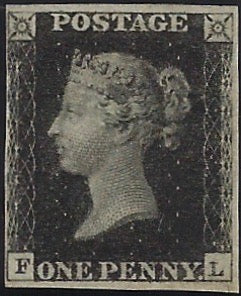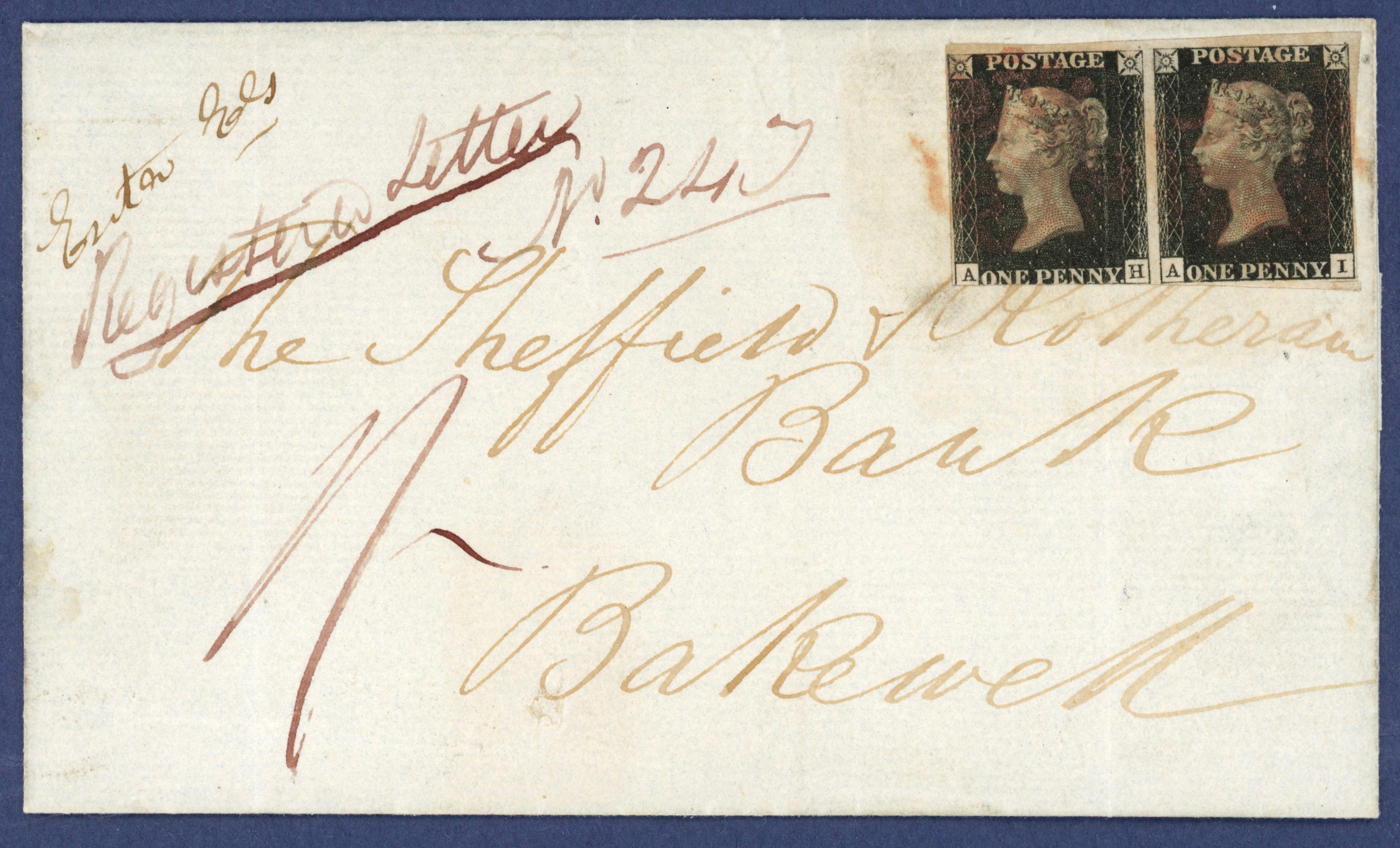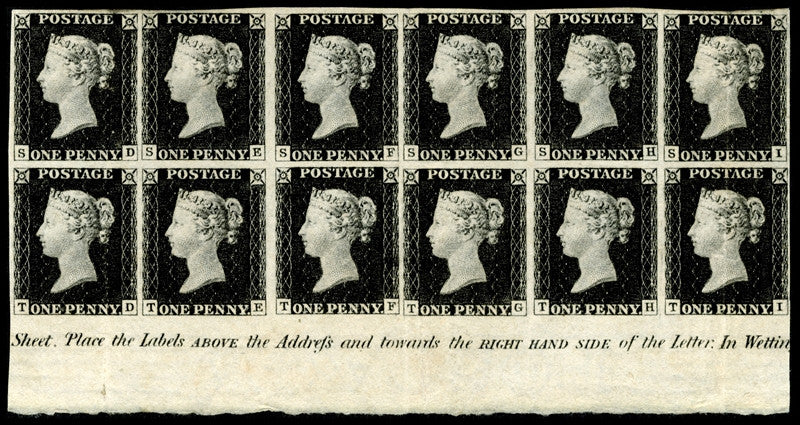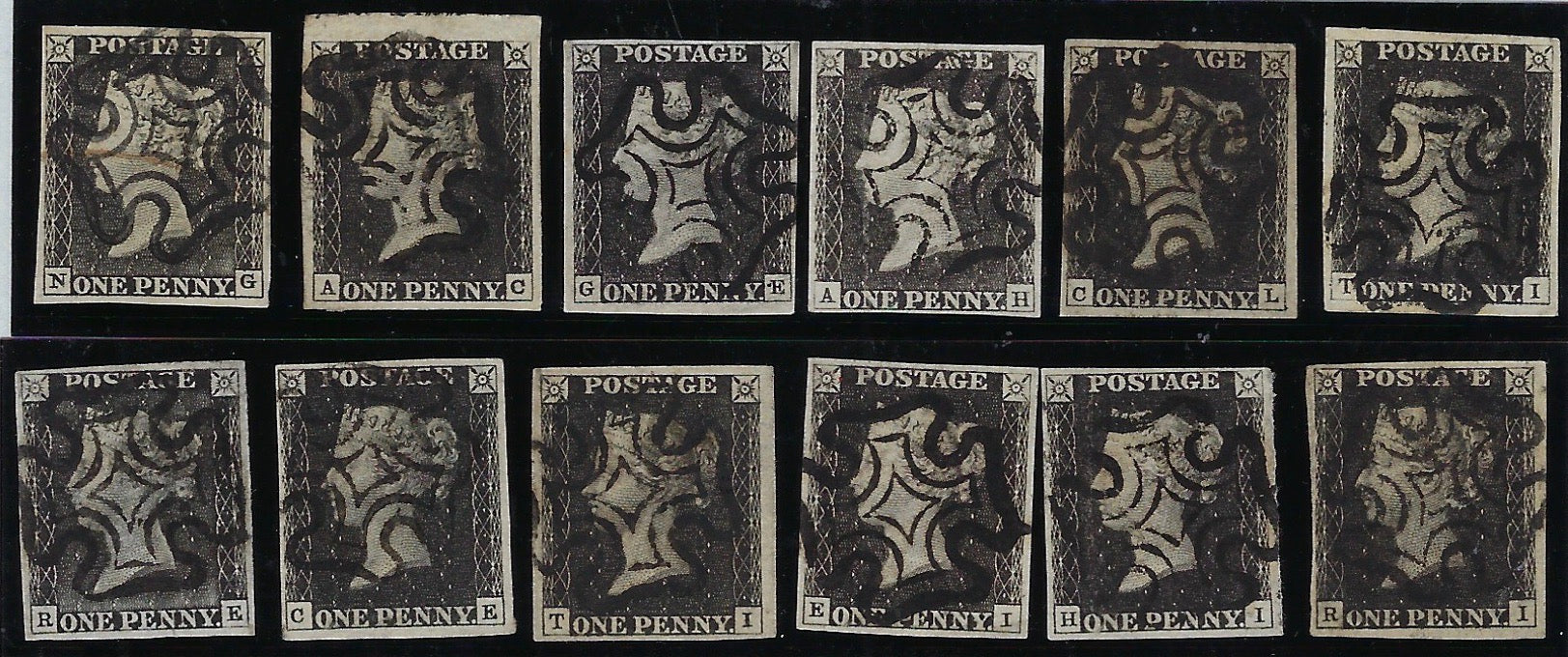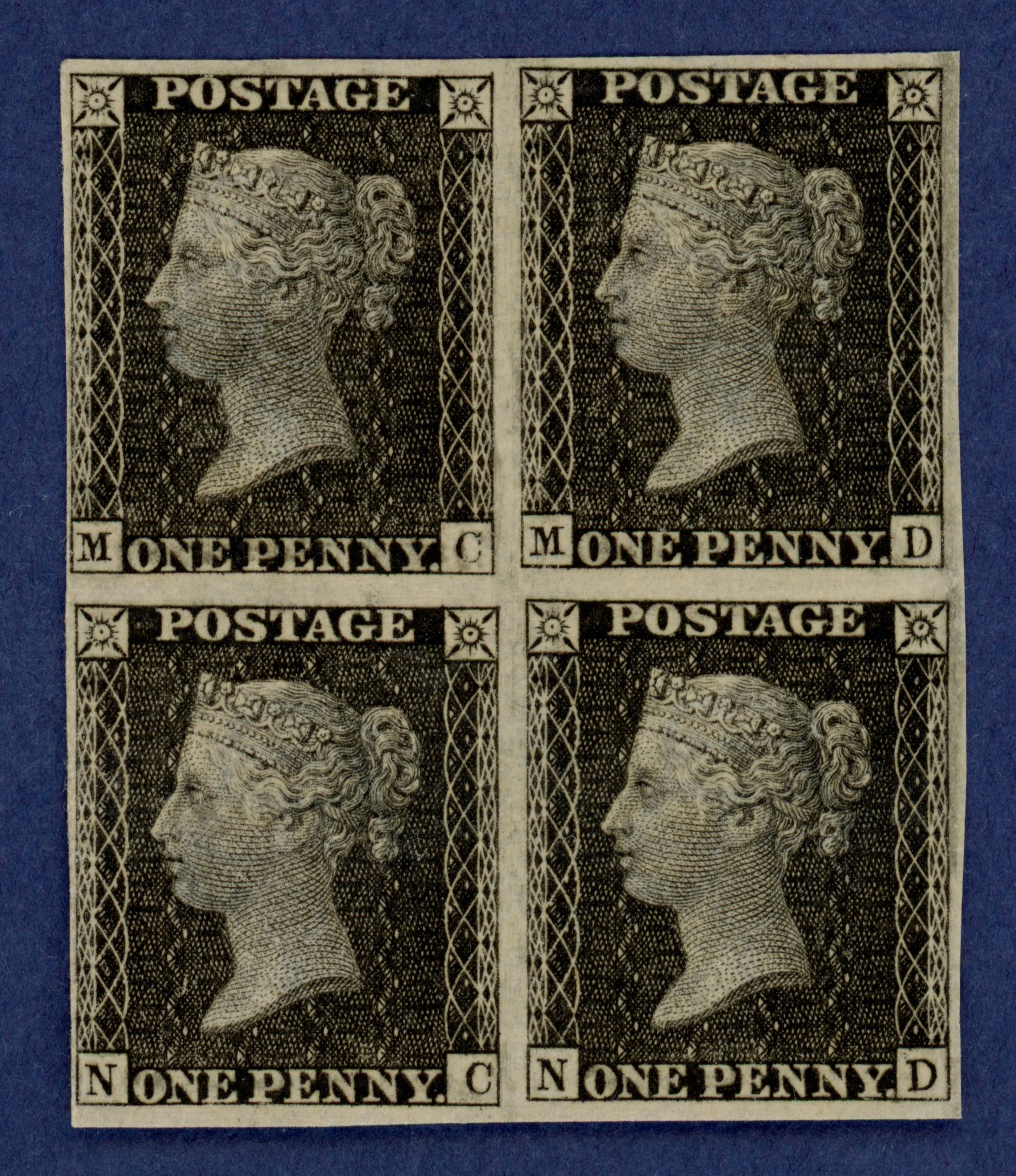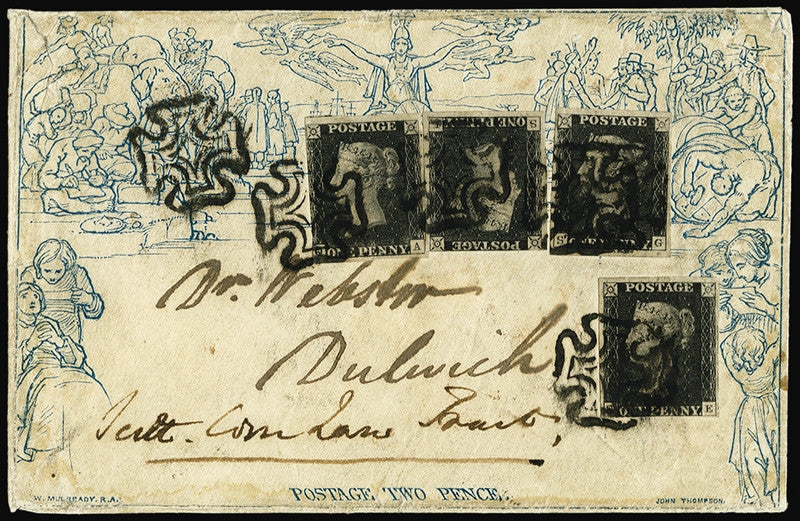You own a Penny Black?
Congratulations!
However, there were once around 68 million more of them in the world.
Yours will be valuable if it is:
- In good condition - front and back, including the gum
- If used, was used at an interesting date or location
- With a good cancellation stamp
- Is well presented
- Is part of a group
- Is in an unusual position from a sheet, and carries extra margins or text
- Is from one of the rarer printing plates
- Is a printing error
- Or a proof, imprimatur or other pre-issue design stage
Let’s have a look:
1 - Penny Black condition
This Penny Black is in "very fine, fresh" condition.
Penny blacks are old. They were first issued to the public on May 1, 1840.
But many survive and many are in remarkably good condition.
They’re rated just like any other stamp:
Condition ratings also take in some presentationional aspects of the stamp, like how well centred it is.
Penny Blacks are unperforated, so they were cut from sheets with scissors; centring and margin size are important. Collectors will pay more for larger, even margins on all sides of the stamp.
The gum is rated on unused stamps. “Mint never-hinged” is the perfect rating.
Hinges were used by generations of collectors, but they can damage the back of the stamp. If you have hinged stamps and would like to remove them, please seek expert advice before you do.
This gum rating may be provided separately from a more general condition assessment that should look like this:
Superb - perfect or close to it
Extra or extremely fine is perfectly centered and has wide margins
Very fine has good centring and decent margins
Fine stamps have four margins, but the cutting has offset the stamp significantly
Average means that one margin at least has gone, cutting into the stamp’s printed area
Poor stamps are rarely sold
The cancellation, the ink stamp that marked a stamp as used, will also be considered. If it is so heavy it impinges on the stamp’s visual appeal it will push the condition down.
Penny Blacks were cancelled with a Maltese cross stamp in red ink.
2 - Penny Black date and location
A date stamp on the rear dates this envelope and stamps to February 1841. The arrangement of stamps and postal type is unique.
Stamps excite me because they’re historic documents.
The Penny Black uniquely so.
Used stamps that can be tied to dates early in the Penny Black’s history (they were withdrawn after less than a year) will attract a premium.
The cancellations weren’t dated, so only stamps attached to dated letters or envelopes with the dated post office dispatch stamps can be definitively dated.
May 6 was the first official day of use (though some very rare uses predate that), and the earlier the date the better. Sunday postings, which were unusual, are prized.
3 - Valuable Penny Black presentation
Used Penny Black’s come in a large variety of states.
Their presentation is recorded in part in their condition - size of margin, clear printing and so on - as a mint stamp.
But also in how the cancellation was applied and where they are affixed to a letter or envelope.
A used Penny Black with a good, Maltese cross cancellation.
This is somewhat a matter of taste, but clarity and space are highly valued by Penny Black collectors.
A used Penny Black that has been neatly gummed (a description will say “tied”) on an envelope and where the red cancellation stamp doesn’t obscure the printed image too much is preferable.
4 - Penny Black groups
Groups of stamps are almost always more valuable than singles.
In short, because that’s rarer. Most stamps are designed to be used as a standalone payments.
And so it is with Penny Blacks.
The postage system they helped found was designed to be simple. Most letters and packages could be sent with a single postage stamp.
You could post a ½ ounce (14g) package any distance with a single penny black. The 2d stamp existed for larger packets.
So, used pairs are very rare.
In fact, any group is rare. Pairs, fours, strips, blocks. Mint or posted and cancelled. Blocks from corners are treasured, as are strips from sheet edges.
The man often described as the "world's first stamp collector", John Edward Gray, bought a block of four Penny Blacks on the first day of issue.
The only full surviving full sheets are thought to be in the UK’s Postal Museum.
5 - Penny Black sheet position
This group is extraordinary, and shows attractive marginal text.
Rarity again makes Penny Blacks from the edges of sheets more valuable.
More so if they are visibly from the sides of a sheet.
They can be positioned with the letters of course, but visible wide margins are highly sought after, particularly if they capture some of the text that ran around Penny Black sheets.
That was the user manual.
This was brand new tech remember, so Post Office staff needed directions, they were told:
“Place the labels ABOVE the address and towards the RIGHT HAND SIDE of the letter. In wetting the back be careful not to remove the cement.”
Sections of this text, particularly if legible and long, are attractive to buyers.
6 - Penny Black plates value
This set shows an example from every plate used to print Penny Blacks.
The Penny Black was relatively short-lived, but in that time it saw off 11 numbered printing plates that we now count as 12.
Pioneers often need to refine their processes, and the stamp printers were no exception. This was an extraordinary job - printing nearly 69 million stamps that had to be super accurate.
The first plate broke and repairs to it were so extensive that the revamped version is recognised as a separate plate by collectors.
The usual formula applies: the rarer the stamp the more valuable, so stamps from those plates that printed fewer stamps are more valuable.
There were 12 plates in total. Specialists can recognise each one. Go to a stamp forum and you will find guides to doing it, but it is very detailed work.
The differences are found in the locating corner letters that were hand stamped into each plate, the stars in the top corners, the guidelines used to align the stamps, and the use of double letters.
Any of these combinations of marks on a stamp may add to its rarity and attraction as well as confirming from which plate it came.
The “O flaw" is a tiny irregularity that developed on the O in the word “one” in plates 7, 8, 9 and 10. As it appeared over time, it is not present in all stamps from those plates.
The rarest plate is plate 11 (the 12th, as the double first plate is split into 1a and the repaired 1b).
Plate 11 was made to print the Penny Red that soon replaced the black. But the plate was ready before the new red ink, so it was pressed into service to run off the final, emergency, supply of Penny Blacks, just 168,000 of them.
7 - Penny Black printing errors
Errors on Penny Blacks are rare. And that makes them valuable.
The “O flaw” on that run of plates from 7 to 10 is one.
Otherwise misplaced watermarks are the most likely source of errors.
Their value is best summarised as what someone is willing to pay for them, but they are certainly rare, interesting and collectible.
This curiosity is from the Royal Reprint, made for stamp enthusiasts in the royal family. Anything unusual or rare is of interest and value to collectors.
8 - Penny black production process
The Penny Black was supposed to be designed by competition.
The entries didn’t quite hit the mark, according to Rowland Hill, the main pilot of the project.
But they are now valuable collectibles.
There were 2,600 entries for the original treasury competition, these are called "the Treasury Essays".
Just four went on to the next stage and test printings.
Some of the best-known entries are by Charles Whiting, James Chalmers and Henry Cole. All are collectible and valuable to specialist philatelists.
Alongside the Penny Black, the Post Office also issued stationary called Mulready letters, named after the artist whose work illustrated them. These were sheets of paper on which a message could be written, or that could be folded to hold another letter and that were sold as pre-paid for postage.
A Mulready with additional postage in the form of Penny Blacks: extraordinary.
The public hated them.
They’re now another form of Penny Black collectibles.
As Rowland Hill’s own design progressed towards production, it was tested along the way.
Some of the test images can be found for sale. Imprimaturs are prints taken to confirm that a printing plate is ready for use. These will cost a collector 10s or even hundreds of thousands of pounds to own.
Penny Blacks for you now
I think every complete stamp collection should contain a Penny Black. And most people can afford one.
There are so many varieties that valuation is incredibly complex and difficult. Many stamps - particularly at the top end of the market - are sold by auction. This is a notoriously hard-to-judge way of setting prices.
My best advice to Penny Black owners who would like to know their value is to take them to a reputable dealer - we're happy to help - and ask for a valuation. As with every other stamp, provenance (the stamp's history) and authenticity are also vital contributors to real value.
Penny Black collecting is a wonderful specialism in its own right.
Have you the time, money, skill and patience to recreate a full plate from its 240 uniquely lettered squares?
We have an excellent selection of Penny Blacks for sale here.
And you can sign up for our newsletter - for more pieces like this, the first chance to see our new acquisitions and much more - here.


